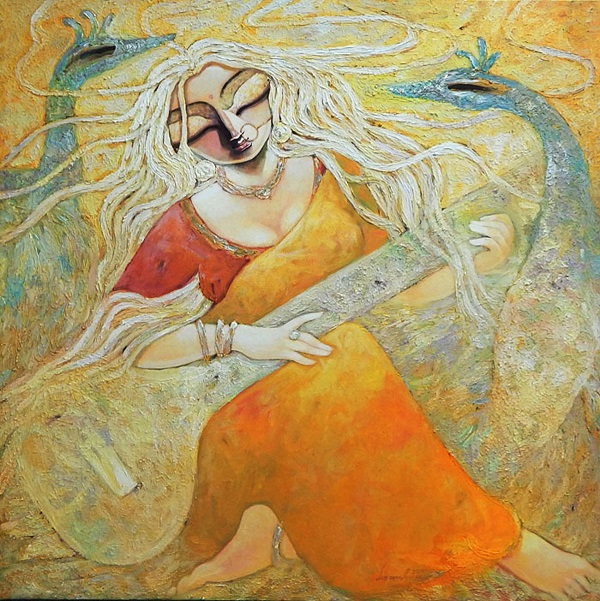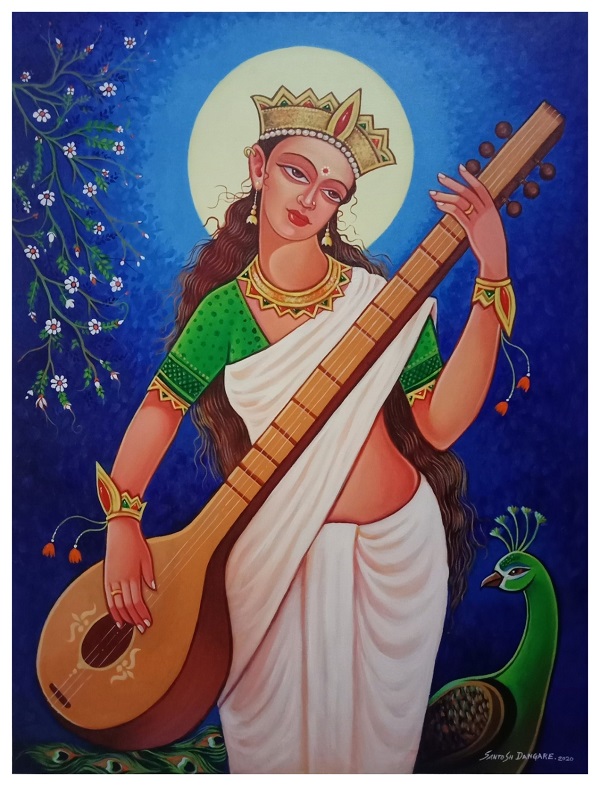
Indian art showcases Saraswati paintings as captivating displays of imagination and spirituality. Saraswati has been a source of inspiration for creative individuals since ancient times. The paintings of Saraswati demonstrate artistic skill and hold a significant place in Indian culture.
We will examine the reasons behind the captivating appeal of these paintings to both hearts and minds in this comprehensive blog post. Let's delve into the rich reservoir of wisdom.
Historic Roots
To understand the significance of Saraswati paintings, it is essential to understand their historical context. The Rigveda and Puranas, two ancient Indian texts, mention Saraswati, a goddess of wisdom and knowledge. Saraswati, depicted as a graceful figure adorned with symbols of wisdom, represents the pursuit of knowledge, creativity, and the arts.
The goddess Saraswati is a prominent figure in indigenous art forms, including classical Indian art, sculpture, and literary works. Artists have drawn inspiration from her divine qualities for centuries, expressing her in a variety of styles and media.
The way Saraswati presents herself has been a constant one, showcasing her quest for knowledge and artistic expression, from the exquisite Ajanta and Ellora cave paintings to the intricate Madhubani and Pattachitra art.
Symbolic Meaning of Saraswati Paintings
Saraswati is depicted as a serene and graceful being, often seated on a lotus or swan, and adorned with symbols representing wisdom and creativity. In Saraswati's paintings, a musical instrument symbolizes the harmony between knowledge and creativity. The lotus, a common symbol in Hindu mythology, emphasizes Saraswati's divine qualities.
Furthermore, Saraswati is often portrayed in white attire, a representation of purity and transcendence from material desires. She has four limbs that represent the five distinct aspects of our individuality.
Her hands carry several symbols, including a book (symbolizing wisdom), a rosary (symbolizing contemplation), and a water pot (symbolizing purification) are some of the symbols she carries in her hands.

Significance of Saraswati Paintings in Indian Culture
1. Symbolism and Iconography:
Each element in the Saraswati paintings is carefully chosen to convey a profound meaning. The four arms of Saraswati are often used to represent her omnipresence and power. A veena (stringed instrument) represents the harmony of music and knowledge, a book represents wisdom, a mala represents concentration, and sometimes a lotus represents purity and transcendence.
Grace and discernment are represented by the swan, while the peacock, another associated symbol, represents beauty and fertility. These symbols not only enhance the visual appeal but also enrich the narrative, beckoning viewers to consider the deeper meanings enshrined within the artwork.
2. Cultural Reverence:
Saraswati is often depicted as a serene and graceful being, often seated on a lotus or swan and adorned with symbols representing wisdom and creativity. Saraswati's paintings symbolize the harmony between knowledge and the arts. The lotus is a frequent motif in Hindu mythology, highlighting Saraswati's divine attributes.
Moreover, Saraswati is frequently depicted in white attire, a symbol of purity and transcendence from material desires. She has four limbs that represent five distinct aspects of our individuality.
3. Artistic Expression:
Saraswati paintings employ a diverse range of artistic styles and techniques, spanning from classical to contemporary. Traditional artists use techniques such as miniature painting, Tanjore painting, and Madhubani art to portray Saraswati in all her glory. Contemporary artists are exploring new techniques and aesthetics, which gives Saraswati painting a fresh take while remaining true to its subject.
Due to their combination of emotions and intellect, Saraswati paintings have a captivating appeal. Each of the paintings conveys a distinct narrative, inviting viewers to embark on a journey of self-discovery and illumination.

4. Global Influence:
An era of globalization has captivated admirers with Saraswati paintings. They have a timeless beauty and spiritual significance that attracts collectors and art lovers alike. The extensiveness of Indian art and culture is showcased in museums and galleries across the globe.
Saraswati's universal message of wisdom and inventiveness encourages cross-cultural interaction and understanding. Linguistic, cultural, and philosophical obstacles exist in a world plagued by division and conflict
5. Ritualistic Importance:
Various ceremonies and festivals include Saraswati paintings, which are more than just pretty pictures. The yearly Saraswati Puja features elaborate paintings depicting the goddess, accompanied by customary rituals and offerings. Artists praise her for her inspiration and inventiveness, while scholars strive for academic achievement.
Furthermore, Saraswati's paintings can be found throughout educational establishments, serving as a constant reminder of the pursuit of knowledge and excellence. Teachers and students alike revere Saraswati, who aids them in their learning journeys and academic endeavors.
6. Evolution of Style:
Saraswati's paintings have undergone a gradual evolution, revealing the shifting social and cultural landscape of India. The intricate brushwork of the Mughal miniatures and the bold colors of the Bengal school have left a mark on Saraswati's painting.
The Saraswati paintings incorporated Persian influences during the Mughal era, resulting in a fusion of Indian and Persian artistic sensibilities. Nevertheless, the Bengal school embraced indigenous motifs and techniques, portraying Saraswati in a more simplistic, yet powerful manner.
Saraswati paintings have incorporated a mix of traditional and contemporary elements, accommodating a diverse range of preferences and sensibilities. Artists explore novel media, techniques, and themes, reviving outdated customs while remaining rooted in the renowned cultural heritage of India.
7. Inspiration for Creativity:
Saraswati paintings serve as a source of inspiration for artists, writers, musicians, and scholars. His composed demeanor and eminent wisdom inspire creative imagining and foster a sense of artistic fervor.
Numerous renowned artists have benefited from Saraswati's divine grace in their artistic creations. Her writing abilities are highly sought after by writers, while her musical abilities are invoked. She inspires artists to strive for excellence and ingenuity in their respective fields.
8. Educational Symbol:
The transformative power of learning and understanding is represented in the paintings of Saraswati. Being the embodiment of wisdom, insight, and intellectual prowess makes her an iconic figure in the realm of education.
Educational establishments are adorned with Saraswati paintings to remind students of the noble pursuit of knowledge and the importance of continuous learning. The hunger for knowledge and academic excellence is stoked by her constant inspiration and motivation.

Read More: Exquisite Saraswati Paintings Depicting Music and Literature
Wrapping Up!
In Indian culture, the significance of Saraswati paintings encompasses spirituality, creativity, and intellectual pursuit. The wisdom and exquisiteness of Indian art are immortalized in Saraswati paintings, which span their ancient origins to their contemporary manifestations.
We should contemplate the intricate details and profound symbolic significance of Saraswati paintings as we gaze at them, not just for their aesthetic appeal. Saraswati beckons us to discover ourselves and gain valuable insights, paving the way for a brighter and wiser future.
The Saraswati paintings showcase devotion, creativity, and academic pursuit in the vibrant Indian culture. The infinite potential that lies within us should be reminded of.
The artistic creations of Saraswati give us comfort, awe, and hope for a better future. We're hoping that Saraswati's divine light continues to shine on our lives and help us gain wisdom and knowledge.
FAQs:
Are Saraswati paintings only religious, or do they have broader cultural significance?
There are deep religious roots in Hindu mythology, but they also have a wider cultural significance beyond religious boundaries. They pay tribute to the fundamental qualities of understanding, artistic endeavors, and inventive thinking, which are universal principles dear to people from a variety of backgrounds. People looking for intellectual insight and artistic inspiration, regardless of their religious beliefs, are impacted by Saraswati artwork.
How have Saraswati paintings evolved in Indian art?
Saraswati paintings have evolved, adapting to changing artistic styles and cultural preferences. Traditional depictions of Saraswati often follow classical iconography, while contemporary artists explore innovative ways to portray the goddess while still preserving her essence. This evolution reflects the dynamic nature of Indian art and its ability to reinterpret ancient symbols in modern contexts.
How do Saraswati paintings contribute to the cultural identity of India?
India's cultural identity is greatly enhanced by Saraswati paintings, which represent India's rich heritage of spirituality, art, and learning. Indian culture is characterized by its reverence for knowledge, creativity, and the arts, which are fundamental components of the nation's culture.
What themes are commonly depicted in Saraswati paintings?
Saraswati paintings often show things like education, music and art, wisdom, and spirituality. Saraswati is usually shown sitting on a lotus with her veena in hand. This shows that she is associated with creativity and the arts.





















